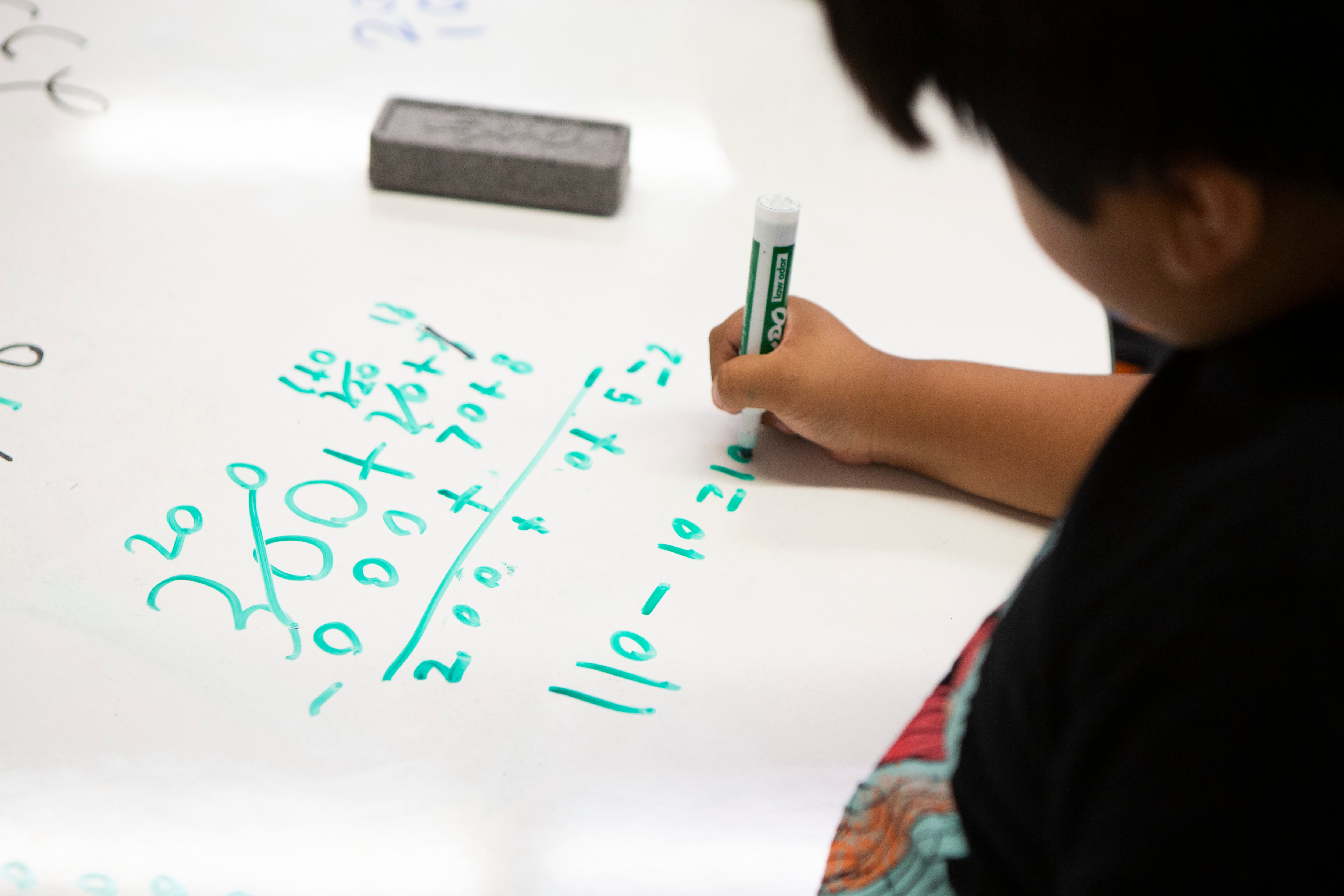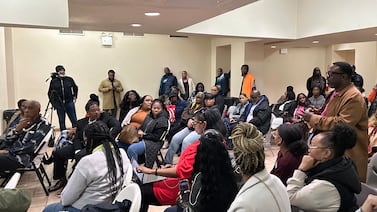Sign up for Chalkbeat Indiana’s free daily newsletter to keep up with Indianapolis Public Schools, Marion County’s township districts, and statewide education news.
Two years after Indiana made big changes to reading instruction, state policymakers want to see a similar shift in math.
A bill advancing through the state legislature would place new requirements for math instruction on teacher prep programs, while also requiring schools to screen young students for math proficiency and offer interventions for those who need them.
House Bill 1634 would also require older students who are proficient in math to be auto-enrolled in advanced math courses.
The idea behind the bill is based on Indiana’s reading overhaul, which over two years has changed the way universities train teachers and the way teachers teach reading, aligning both to a set of practices known as the science of reading.
Lawmakers and state education leaders have linked the state’s reading efforts to its performance on the National Assessment of Educational Progress, which this year showed that Indiana students improved their reading scores even as reading scores nationally continued to decline.
“Hopefully we can do something similar to that in regard to math,” said Republican Rep. Jake Teshka, the bill’s author.
But while Indiana followed in the footsteps of states like Mississippi to implement the principles of the science of reading, the template for overhauling math isn’t so clear-cut.
Only a handful of other states have passed laws requiring screeners or extra training for elementary teachers in math. There’s also less research about the best way to teach math, though advocates broadly describe two camps that emphasize either explicit instruction or student-led discovery.
Students in fourth grade improved their math scores on the NAEP slightly, but Indiana’s eighth graders continued to decline, a trend that began in 2019.
And the state may face pushback from teachers and teacher prep programs as it did with the reading changes, which required extra training and monitoring on top of existing requirements.
“There’s not a recipe in our country that we can just take from another state that has scaled the work and do it,” said Indiana Secretary of Education Katie Jenner at a hearing on the bill. “It’s an opportunity to move with urgency but also learn throughout the process.”
House Bill 1634 passed unanimously out of the House Education Committee on Wednesday.
What the bill means for teachers and prep programs
The bill tasks the Department of Education with developing guidelines for teacher preparation programs, in order to ensure that the curriculum they’re using is “aligned with evidence-based instructional strategies to promote: conceptual understanding; procedural fluency; and real world problem solving.”
The department must also review the state’s teacher prep programs to ensure they’re following these rules. Those who aren’t could face losing the “right to use the word ‘accredited.’” The state instituted similar requirements when it changed mandates for reading instruction two years ago.
A lot of the math instruction in schools today combines procedural and conceptual instruction, said Sarah Powell, a professor of special education at the University of Texas at Austin, whose research focuses on math.
But she added that in the last couple of decades, schools heavily emphasized conceptual understanding, or why a problem-solving approach works, rather than procedural understanding, or how to do the steps to solve a problem.
The issue with conceptual understanding is that “people learn through modeling or practice,” she said.
“You watch a YouTube video, pause it, practice, and finally you can tile your bathroom,” Powell said.
Since the push for the science of reading gained national attention, educators have applied a similar lens to math.
“A lot of schools are saying, wait a minute — if we have to explicitly teach reading, do we have to explicitly teach math?” Powell said. “We have a lot of evidence about the best ways to learn math, but not a lot of the best ways to teach math have been in place.”
Still, some researchers are wary of a mandate to teach math in any one specific way, especially when that mandate creates a burden for universities.
Enrique Galindo, an associate professor of mathematics at Indiana University who spoke in a personal capacity, said there’s likely not just one solution. Instead, teachers should be prepared to utilize a number of different strategies for different students who have different strengths.
“I think the problem is when legislation wants to mandate what to teach and how to teach, it basically does not trust higher education institutions that the state funds with taxpayer dollars to do their work,” Galindo said.
The main issue with a procedural-based approach “is that it doesn’t develop the kind of thinkers we need today to be successful in society,” he said.
“We need to prepare students who are problem solvers, who understand what they’re doing,” he said. “In the past we valued just getting to the right answer. But now you need to know how you do it, and how to explain it to others.”
(Powell and Galindo spoke to Chalkbeat before the details of the Indiana bill were available.)
Indiana lawmakers hope to avoid the duel of philosophies that marked the science of reading debate.
Rep. Bob Behning, a Republican and the chair of the House Education Committee, pointed out that teachers who had been trained in one method of teaching literacy — like balanced literacy — had to relearn techniques.
But less formal training in math in many instances for teachers in training may mean that educators are less comfortable tackling the topic.
Jenner said the state is seeking philanthropic contributions to help with the costs of implementing voluntary professional development for teachers aimed at boosting their confidence in teaching math.
In 2022, the Lilly Endowment gave around $85 million to place literacy coaches in Indiana schools and offer teachers stipends for taking professional development in the science of reading, among other literacy initiatives.
“Not every teacher who teaches math is in love with math,” Powell said. “A lot of elementary teachers, they love reading and want students to be readers.”
What the math bill means for students
The bill would require students in grades K-2 to take numeracy screeners, while those in older grades would continue to take the state math test, the ILEARN.
Students who score low on these screeners and tests would qualify for interventions, which must also be aligned to the ideas of conceptual understanding, procedural fluency, and real-world application, and happen on top of their regular classroom instruction.
Powell said schools have long recognized the power of reading instruction and intervention, but fewer schools take the same approach with math. Early math intervention could help students build skills for future grades, and eventually, future careers.
“If you have a hard time adding and subtracting, guess what, multiplication and division are hard,” Powell said.
Galindo said another solution for schools could be hiring math coaches who work with teachers to provide feedback and help prepare lessons. If a school provides numeracy screeners to young students, the screeners should narrowly define the skills students need at that age, he said.
In addition, the bill would require that students who demonstrate proficiency in math in middle school on the ILEARN or through their grades be enrolled in an advanced math class in the next grade. This idea drew some concerns from educators who said proficiency does not necessarily mean that a student is ready for advanced math.
When the House committee passed HB 1634, there was a round of applause for Jenner for the state’s recent NAEP reading results.
“I believe our schools will continue to improve, because the better a kid can read, the better they can do math,” said Democratic Rep. Tonya Pfaff, a math teacher.
Aleksandra Appleton covers Indiana education policy and writes about K-12 schools across the state. Contact her at aappleton@chalkbeat.org.






